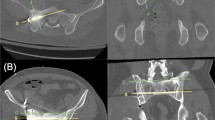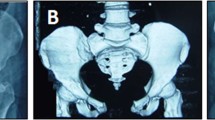Abstract
Objective
Percutaneous iliosacral screw placement allows for minimally invasive fixation of posterior pelvic ring instabilities. The objective of this study was to describe the technique for screws in S1 and S2 using conventional C-arm and to evaluate perioperative complications.
Methods
Thirty-eight consecutive patients after percutaneous pelvic ring fixation with cannulated screws in S1 and S2 using conventional C-arm fluoroscopy were analysed. Accuracy of screw placement, nerval lesions, need for second surgery, operation time, and time to full weight bearing were assessed postoperatively and during regular follow-up examinations.
Results
Twenty-one patients underwent unilateral screw fixation and 17 patients underwent bilateral screw fixation. In total, 83 screws were placed. Mean age of the patients was 52 ± 19 years. Mean operation time was 16 ± 7 min/screw. Mean follow-up was 5 ± 3 months. Time to full weight bearing in 28 patients was 9 ± 4 weeks. Eight patients were still not able to support full weight bearing, partially due to concomitant injuries. Patients without concomitant injuries that affected walking were able to bear full weight after 8 ± 4 weeks (n = 17). Two patients had persistent postoperative hypaesthesia. No motor weakness was apparent and no postoperative bleeding was observed. Secondary surgery due to screw malpositioning or loosening had to be performed in four patients. The presence of a screw in S2 was not indicated for perioperative complications.
Conclusions
Percutaneous iliosacral screw fixation is a rapid and definitive treatment for posterior pelvic ring injuries with a low risk of secondary bleeding during posterior pelvic stabilization. The technique using standard C-arm fluoroscopy was also found to be safe for screws placed in S2.


Similar content being viewed by others
References
Briem D, Rueger J, Begemann P et al (2006) Computerassistierte Verschraubung des hinteren Beckenrings. Unfallchirurg 109(8):640–646
Briem D, Windolf J, Rueger JM (2007) Perkutane, 2D-fluoroskopisch navigierte Sakrumverschraubung in Rückenlage. Der Unfallchirurg 110(5):393–401
Farrell EDMD, Gardner MJMD, Krieg JCMD, Chip Routt MLJMD (2009) The upper sacral nerve root tunnel: an anatomic and clinical study. J Orthop Trauma 23(5):333–339
Furey AJMDF, O’Toole RVMD, Nascone JWMD, Sciadini MFMD, Copeland CEMD, Turen CMD (2009) Classification of pelvic fractures: analysis of inter and intraobserver variability using the Young-Burgess and Tile classification systems. Orthopedics 32(6):401–406
Gänsslen A, Hüfner T, Krettek C (2006) Percutaneous iliosacral screw fixation of unstable pelvic injuries by conventional fluoroscopy. Oper Orthop Traumatol 18(3):225–244
Gautier E, Bächler R, Heini PF, Nolte LP (2001) Accuracy of computer-guided screw fixation of the sacroiliac joint. Clin Orthop Relat Res 393:310–317
Gunterberg B, Goldie I, Slätis P (1978) Fixation of pelvic fractures and dislocations. An experimental study on the loading of pelvic fractures and sacro iliac dislocations after external compression fixation. Acta Orthop Scand 49(3):278–286
Hilgert RE, Finn J, Egbers HJ (2005) [Technique for percutaneous iliosacral screw insertion with conventional C-arm radiography]. Unfallchirurg 108(11):954, 956–960
Jacob AL, Messmer P, Stock KW et al (1997) Posterior pelvic ring fractures: closed reduction and percutaneous CT-guided sacroiliac screw fixation. Cardiovasc Intervent Radiol 20(4):285–294
Josten C, Schildhauer TA, Muhr G (1994) [Therapy of unstable sacrum fractures in pelvic ring. Results of of osteosynthesis with early mobilization]. Chirurg 65(11):970–975
Käch K, Trentz O (1994) [Distraction spondylodesis of the sacrum in “vertical shear lesions” of the pelvis]. Unfallchirurg 97(1):28–38
Koo HMDF, Leveridge MMD, Thompson CMD et al (2008) Interobserver reliability of the Young-Burgess and Tile classification systems for fractures of the pelvic ring. J Orthop Trauma 22(6):379–384
Nelson DW, Duwelius PJ (1991) CT-guided fixation of sacral fractures and sacroiliac joint disruptions. Radiology 180(2):527–532
Peng KT, Huang KC, Chen MC, Li YY, Hsu RW (2006) Percutaneous placement of iliosacral screws for unstable pelvic ring injuries: comparison between one and two C-arm fluoroscopic techniques. J Trauma 60(3):602–608
Routt ML Jr (2006) Posterior pelvic-ring disruptions: iliosacral screws. In: Wiss DA (ed) Fractures. Lippincott Williams & Wilkins, Philadelphia, pp 649–667
Routt ML Jr, Simonian PT, Mills WJ (1997) Iliosacral screw fixation: early complications of the percutaneous technique. J Orthop Trauma 11(8):584–589
Schep NW, Haverlag R, van Vugt AB (2004) Computer-assisted versus conventional surgery for insertion of 96 cannulated iliosacral screws in patients with postpartum pelvic pain. J Trauma 57(6):1299–1302
Schildhauer TA, Josten C, Muhr G (2006) Triangular osteosynthesis of vertically unstable sacrum fractures: a new concept allowing early weight-bearing. J Orthop Trauma 20(1 Suppl):S44–S51
Schweitzer D, Zylberberg A, Cordova M, Gonzalez J (2008) Closed reduction and iliosacral percutaneous fixation of unstable pelvic ring fractures. Injury 39(8):869–874
Smith HEMD, Yuan PSMD, Sasso RMD, Papadopolous SMD, Vaccaro ARMD (2006) An evaluation of image-guided technologies in the placement of percutaneous iliosacral screws. Spine 31(2):234–238
Suzuki T, Hak DJ, Ziran BH et al (2009) Outcome and complications of posterior transiliac plating for vertically unstable sacral fractures. Injury 40(4):405–409
Tile M (1988) Pelvic ring fractures: should they be fixed? J Bone Joint Surg Br 70(1):1–12
van den Bosch EWMD, van Zwienen CMAMD, van Vugt ABMD (2002) Fluoroscopic positioning of sacroiliac screws in 88 patients. J Trauma 53(1):44–48
van Zwienen CMAM, van den Bosch EWMDP, Snijders CJP, Kleinrensink GJP, van Vugt ABMDP (2004) Biomechanical comparison of sacroiliac screw techniques for unstable pelvic ring fractures. J Orthop Trauma 18(9):589–595
Yinger K, Scalise J, Olson SA, Bay BK, Finkemeier CG (2003) Biomechanical comparison of posterior pelvic ring fixation. J Orthop Trauma 17(7):481–487
Young JW, Burgess AR, Brumback RJ, Poka A (1986) Pelvic fractures: value of plain radiography in early assessment and management. Radiology 160(2):445–451
Zwingmann J, Konrad G, Kotter E, Sudkamp NP, Oberst M (2009) Computer-navigated iliosacral screw insertion reduces malposition rate and radiation exposure. Clin Orthop Relat Res 467(7):1833–1838
Conflict of interest
The authors declare that they have no conflict of interest.
Author information
Authors and Affiliations
Corresponding author
Rights and permissions
About this article
Cite this article
Osterhoff, G., Ossendorf, C., Wanner, G.A. et al. Percutaneous iliosacral screw fixation in S1 and S2 for posterior pelvic ring injuries: technique and perioperative complications. Arch Orthop Trauma Surg 131, 809–813 (2011). https://doi.org/10.1007/s00402-010-1230-0
Received:
Published:
Issue Date:
DOI: https://doi.org/10.1007/s00402-010-1230-0




